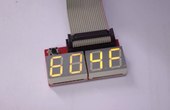Power-on self-test
The POST (from English power-on self-test ) is a self-test after switching on the computer - a process that the computer goes through when it starts up to check whether the basic components of the PC are functional. Any errors that may occur are often reported first by characteristic signal tones and then on the screen after the graphics card has been successfully started up.
procedure
The POST is performed by the BIOS . This is the first program the computer runs after it is turned on.
The POST can be divided into individual steps. The following steps are part of every POST:
- Checking the functionality of the CPU (in multiprocessor systems of the first CPU)
- Check of the CPU-related blocks
- Checking the CMOS RAM ( checksum formation)
- Check of the cache memory close to the CPU
- Checking the first 64 kilobytes of RAM
- Check the graphics memory and the graphics output hardware / software
The graphics card can then be put into operation. The further tests are therefore usually made visible on the screen :
- Check the remaining RAM - this step can be skipped with some BIOS by pressing a key
- Checking the keyboard
- Check of other peripherals , etc. a. Floppy drives and hard drives
During POST there is usually a way to enter a BIOS setup program to change system settings.
Since the implementation of the POST can vary from BIOS to BIOS, additional points may be added or some of the points mentioned may be omitted. Some tests, for example for floppy drives or the full test of the main memory, can also be switched off in the BIOS setup.
Error messages
The BIOS reports errors that are detected during POST directly. If the graphics system has already been checked and in operation, the message appears on the screen; Otherwise, the message is often given by acoustic or visual signals via the system loudspeaker or the flashing of a status display that may be present. The signals of different duration and frequency indicate the type of error. Their meaning depends on the manufacturer of the BIOS.
Output via POST card
A more detailed diagnosis is possible with a POST card , a plug-in card that shows the current status of the POST with the help of LEDs or a numeric display. If the display remains on a value when booting, you can determine the problem with the help of an error code table belonging to the mainboard. The values were originally output continuously from 0x00h (in the event of errors when executing the first BIOS commands on the CPU) to 0xFFh (POST terminated) on the I / O port 0x80h. Depending on the BIOS used and, in some cases, the hardware used, both the order and the meaning of the displayed codes can vary greatly.
Web links
- BIOS compendium: extensive and further information on POST and the BIOS as a whole
- Detailed list of beep codes ( memento from September 12, 2013 in the web archive archive.today )

